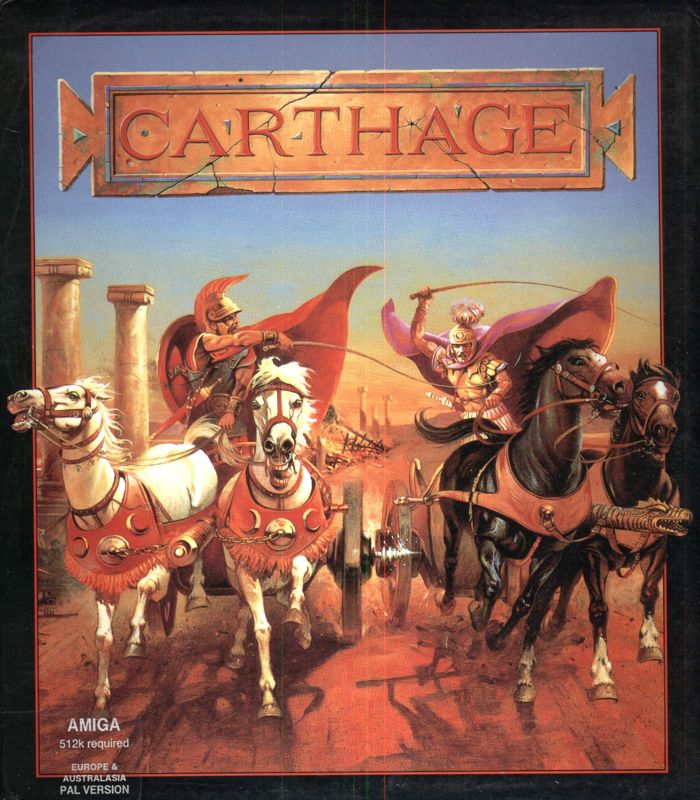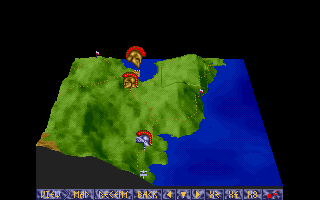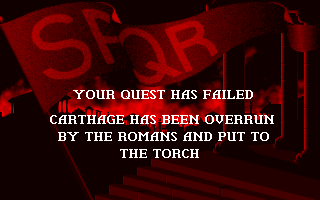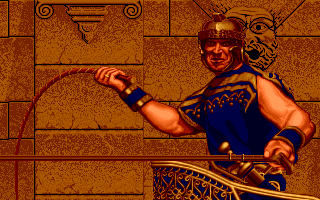Retro Replay Review
Gameplay
Carthage delivers a unique arcade-strategy fusion that will test both your tactical mind and reflexes. At its core, you’re charged with defending the ancient Carthaginian Empire from the ever-advancing Roman legions. Unlike traditional base-building titles, Carthage strips you down to exploration and skirmish tactics: you must discover catapult and elephant-mounted units hidden on the map rather than produce them outright. This creates a rewarding sense of discovery as you scout the hills and valleys of North Africa, knowing that the right find could turn the tide of battle.
The hill-control mechanic is a standout feature. Positioning your infantry on elevated terrain not only grants combat bonuses but also forces you to rethink chokepoint defense. Carthage’s real-time combat rewards thoughtful maneuvering: sending out flanking parties to seize high ground or baiting Roman forces into ambushes. Meanwhile, your veteran units grow in skill and morale after victories, creating an emotional investment—watching a once green cohort evolve into battle-hardened veterans feels genuinely satisfying.
Resource management in Carthage centers on producing trade goods and then transporting the proceeds via chariot caravans. This loop is deceptively intricate: you harvest or manufacture items, negotiate trading routes, and load gold onto your chariots. However, the game throws a curveball with its arcade racing-style minigame—suddenly you’re dodging rocks, trees, and enemy Roman chariots on a narrow road. Contact with obstacles or rivals costs you precious coin, adding a pulse-pounding diversion from the strategic layer.
Fatigue and upkeep mechanics add further depth. Even your most skilled elephants and catapults grow tired under constant deployment, and stretched-thin units suffer penalties in morale and combat efficiency. You’ll need to rotate troops out of the line, balance your gold distribution to keep soldiers paid, and decide when to push for a decisive victory or regroup for reinforcement. The interplay between strategy and arcade action keeps the pacing dynamic, though it may feel jarring to players expecting a pure strategy sandbox.
Graphics
Visually, Carthage strikes a pleasing balance between stylized art and functional clarity. The map’s rolling hills, winding rivers, and scattered groves are rendered in warm Mediterranean hues that evoke the era without sacrificing readability. Unit models are distinct: Roman legionaries march in perfect ranks with gleaming shields, while Carthaginian elephants lumber into battle with elaborately painted armor. Catapults and chariots are richly detailed, ensuring you never confuse friendly forces for foes.
Animations are smooth, particularly in combat sequences. Watching an elephant charge through infantry lines feels weighty and impactful, complete with dust clouds and shaking screens. Siege engines recoil realistically when firing, and the scattered defenders react appropriately, bolstering the sensation of a living battlefield. The arcade racing segments shift to a more dynamic camera angle, emphasizing speed and danger—though some players may find the transition abrupt.
UI elements are clean and intuitive. The strategic overlay clearly highlights unit statuses—morale, fatigue, and experience levels—without cluttering the view. A mini-map in the corner tracks your scouting progress, while on-screen prompts guide you through the chariot runs. Although the interface leans on icons rather than text, it’s easy to learn and offers quick access to essential commands.
One minor gripe is the repetition of environmental assets. After several missions, you may notice the same rock outcroppings and tree models reused across different maps. While this doesn’t hamper gameplay, it can slightly undercut immersion for players who crave visual variety. Still, for a game blending two genres, Carthage holds its own with a cohesive and attractive presentation.
Story
Carthage doesn’t rely on a sprawling narrative campaign; instead, it delivers its story through mission briefs, environmental storytelling, and emergent events on the battlefield. You step into the sandals of a Carthaginian warlord tasked by the senate to repel Roman incursions and maintain your city’s prosperity. Each mission adds a layer of context—villagers rally behind your banners, while the shadow of Rome’s eagle standard looms ever closer.
Dialogue is sparse but effective—tacticians and messengers deliver crisp, focused instructions that emphasize urgency and stakes. You get glimpses of internal politics as city elders debate the war’s toll on Carthage’s coffers, and traders grumble about supply line dangers. These snippets help ground the gameplay in a living world, even if you don’t experience a branching storyline or character arcs.
The emergent narrative is where Carthage truly shines. When your veteran phalanx repels a Roman assault at great cost, or when a daring chariot run sees you narrowly escape enemy ramshackle war wagons, you forge your own tales of triumph and survival. Elephant-mounted units breaking through enemy lines or a late-game fatigue collapse can inspire unforgettable moments you’ll recount to friends.
While hardcore history buffs may lament the lack of deeper historical exposition, the game’s focus on action and strategy keeps the pace brisk. Carthage is less about re-enacting specific battles and more about capturing the essence of a civilization under siege, giving you enough narrative hooks to stay invested without bogging down the flow.
Overall Experience
Carthage stands out for its inventive blend of strategy depth and arcade tension. The core gameplay loop—scouting for specialized units, controlling terrain, juggling resources, and embarking on chariot runs—feels fresh, even if certain elements can clash tonally. Players seeking a straightforward city-builder may find the lack of construction options limiting, but those eager for a lean, combat-focused experience will appreciate the streamlined approach.
The learning curve strikes a fair balance. Early missions double as tutorials, teaching you to manage unit fatigue and use hills effectively, while gradually introducing the trade-and-transport mechanic. By mid-game, you’ll be orchestrating multi-front defenses and planning high-risk chariot deliveries with confidence. The occasional stumble—such as the inevitable question of “Why do enemy chariots always run my route?”—is more endearing quirk than fatal flaw.
Replayability is strong thanks to the mission-based structure. Varying terrain layouts, randomized unit placements, and the unpredictable nature of Roman AI ensure no two playthroughs feel identical. For completionists, mastering perfect runs without fatigue or cash losses becomes an enticing challenge, while casual players can enjoy a few relaxing sessions of hill-top skirmishes and rapid-fire chariot races.
In summary, Carthage is a commendable effort to marry two distinct genres into a coherent whole. Its vibrant visuals, engaging tactical demands, and adrenaline-charged minigames make it a worthy purchase for strategy enthusiasts seeking something off the beaten path. If you’re ready to defend one of history’s greatest cities against imperial might—and don’t mind a bit of arcade chaos along the way—Carthage has plenty to offer.
 Retro Replay Retro Replay gaming reviews, news, emulation, geek stuff and more!
Retro Replay Retro Replay gaming reviews, news, emulation, geek stuff and more!









Reviews
There are no reviews yet.